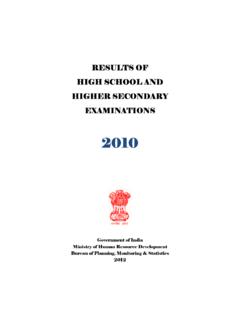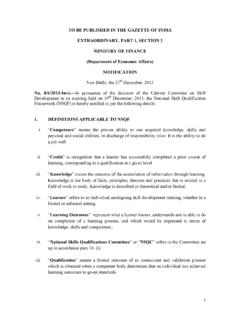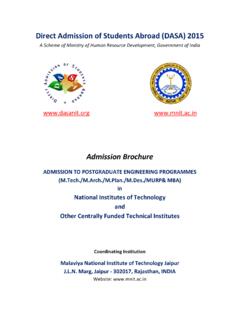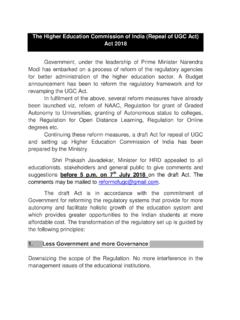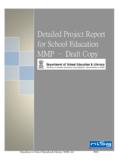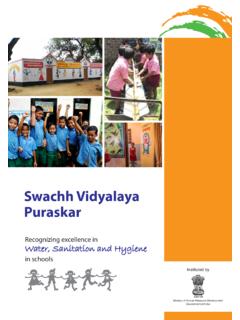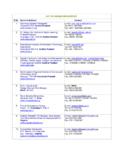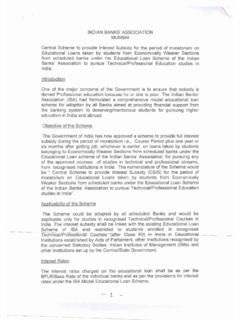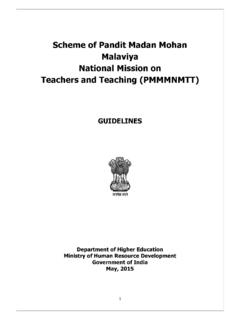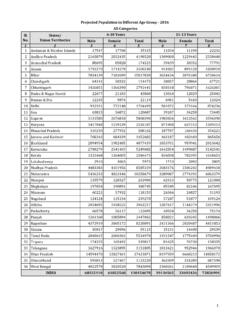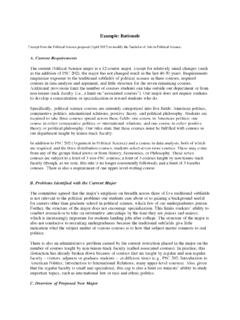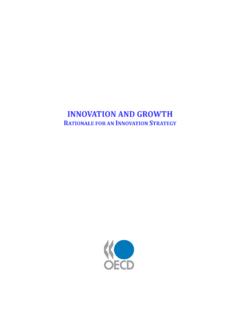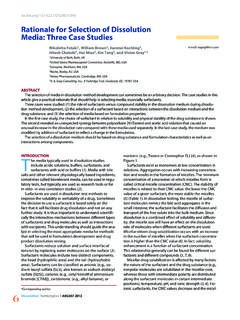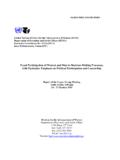Transcription of THE RIGHT OF CHILDREN TO FREE AND …
1 THE RIGHT OF CHILDREN TO free AND compulsory education ACT, 2009. Clarification on Provisions Chapter 1: Preliminary Section 2 defines words and expressions used in the Act. Chapter 2: RIGHT to free and compulsory education Section 3 provides to every child of the age of six to fourteen years the RIGHT to free and compulsory education in a neighbourhood school till the completion of elementary education . The idea of neighbourhood schools can be traced to the National System of education as elaborated in the Kothari Commission report, whereby the neighbourhood school is meant to be a common space, where all CHILDREN cutting across caste, class, gender lines learn together in the best inclusive manner.
2 It is therefore meant to be a site for inclusion, so that the school becomes a common space for education . This concept has been incorporated in the RTE Act. In providing for the RIGHT of every child to free and compulsory education in a neighbourhood school, the RTE Act does not restrict the choice of the child to seek admission in a school which may not be in the neighbourhood of the child's residence. In other words, there is no compulsion on the child to seek admission only in the school in his or her neighbourhood.
3 The term free education ' is explained to mean that no child shall be liable to pay any kind of fee or charges or expenses which may prevent him or her from pursuing and completing elementary education . The term free education ' must be read in consonance with the provisions of section 12(1)(a)-(c) which specify the extent of the school's responsibility for free and compulsory education . It further provides that the provisions of the Persons with Disabilities (Equal Opportunities, Protection and Full Participation) Act, 1996 will apply in the case of CHILDREN suffering from disability as defined under that Act.
4 Section 4 provides CHILDREN above six years, who have either not been admitted to any school or, having been admitted have not completed elementary education and have dropped out, the RIGHT to be admitted to a school in a class appropriate to his or her age for completing elementary education . A majority of out-of-school CHILDREN belong to disadvantaged communities: scheduled castes, scheduled tribes, Muslim minorities, migrants, CHILDREN with special needs, urban deprived CHILDREN , working CHILDREN , CHILDREN in difficult circumstances, for example, those living in difficult terrain, CHILDREN from displaced families, and areas affected by civil strife, etc.
5 This provision in the RTE Act enables these out-of-school CHILDREN to be admitted to an age-appropriate class and complete elementary education . The overall objective of age appropriate admission for these CHILDREN is to save them from the humiliation and embarrassment of sitting with younger CHILDREN . When older CHILDREN are forced to sit in a class younger than their age, they tend to be teased, taunted, suffer lower self esteem, and consequently drop out. The Act facilitates a child admitted to an age appropriate class to be given Special Training to enable him or her to be at par with other CHILDREN .
6 Given the varied life experiences of these CHILDREN , it is recognised in the field of education that their mental capabilities are higher than that of entry level 6-year old CHILDREN , and that they are indeed capable of accelerated learning. At the end of the Special Training, the child will be assessed and his/her suitability for being placed in a particular class will be reviewed. For example, if a 10-year old child was admitted to class IV, and received two years of Special Training till age 12, an assessment may be made as to whether the child could cope better in class V or VI in the formal school, and the child appropriately placed.
7 If such child is found suitable for class V, she/he will be placed in class V, rather than mechanically being placed in class VI because if she/he is mechanically placed in class VI, she/he might again drop out, and that would defeat the whole purpose of this provision. That is the rationale for the provision that allows the child to be provided free and compulsory education even beyond age 14. Even after a child is appropriately placed in the formal school she may continue to receive special attention by the teacher to enable her to successfully integrate with the rest of the class, academically and emotionally.
8 The SSA Framework of Implementation has been revised to provide support for Special Training as envisaged under the RTE Act to ensure that out-of-school CHILDREN are integrated into the school system. Such support will be in the form of residential or non- residential courses, as needed and such CHILDREN will continue even beyond 14 years of age to complete elementary education . The country is committed to creating an educated citizenry and environment, and therefore it would not be appropriate to impose an age ceiling for these CHILDREN to complete elementary education .
9 The obligation under section 4 is on the schools established by the State Government and local authority. Private aided and unaided institutions have no obligations under section 4. Section 5 provides CHILDREN the RIGHT to seek transfer from a Government or Government aided school to another such school in order to complete elementary education and for immediate issue of Transfer Certificate to a child seeking admission to another school. It provides that delay in producing Transfer Certificate shall not be a reason for denying or delaying admission in another school.
10 This provision should lead to States instituting reform to remove procedural barriers to obtaining Transfer Certificates. Chapter-III: Duties of Appropriate Government, Local Authority and Parents. Section 6: The rationale of this provision is to provide all CHILDREN access to elementary education . Universal access requires schooling facilities within reasonable reach of all CHILDREN . If schools are not located in or near the habitations where CHILDREN reside, CHILDREN may not complete schooling, even if they are formally enrolled in schools, on account of distance factors.
